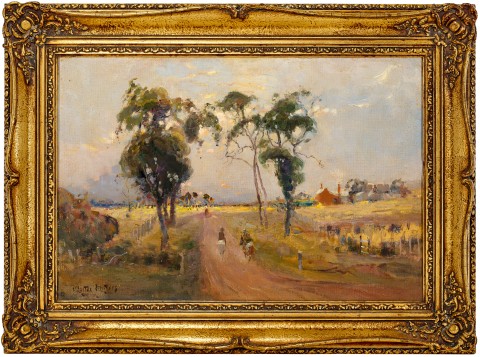The morning ride, c.1894 - 1902
Walter Withers
oil on canvas
36.0 x 54.0 cm
signed lower left: Walter Withers
inscribed on old label verso: Phillip Island
John May, Melbourne, by 1920
Leonard Joel, Melbourne, 24 May 1973, lot 31 (as ‘Phillip Island’)
Sir Leon and Lady Trout, Queensland
Private collection
Sotheby’s, Melbourne, 22 April 1996, lot 61
Private collection, Melbourne
Master Works from the Collection of Sir Leon and Lady Trout, Queensland Art Gallery, Brisbane, 21 September – 14 December 1977, cat. 61 (label attached verso and illus. in exhibition catalogue, as ‘Phillip Island’)
Withers, F., The Life and Art of Walter Withers, Australian Art Books, Melbourne, 1920, pp. 24, 25 (illus.)
‘Melbourne’s private art galleries. Mr John May’s collection. The art of Walter Withers.’, The Age, Melbourne, 12 April 1930, p. 5
Mackenzie, A., Walter Withers: The Forgotten Manuscripts, Mannagum Press, Victoria, 1987, p. 129
Morning Mist, Eltham, oil on canvas, 62.0 x 73.5 cm, private collection
In a photograph of early Heidelberg, the family home of Walter Withers sits on a rise above the railway line. Titled ‘Withers Court’, the handsome double-fronted cottage is located opposite that of John May, a collector more fairly described ‘as a specialiser, for in the pictures which cover the walls of his Heidelberg home, certainly three-fourths are the work of one painter, the late Walter Withers… probably the most representative group of his works collected under one roof.’1 Indeed, Withers’ wife Fanny noted that this painting The morning ride, c.1894 – 1902, was one which took ‘pride of place’ in May’s home2, and it was also one of the small selection of images which she reproduced in 1920 in a small book dedicated to her late husband’s career. In a newspaper article on May’s collection published in 1930, the writer also singled out the painting for praise as ‘another landscape which gives pleasure… A morning ride, charming in composition, and while couched in a low key, is luminous and full of colour movement.’3
Withers rarely travelled far for his subjects and found most around his various homes in Creswick, Heidelberg and Eltham. According to Mrs Withers, The morning ride dates from ‘these Heidelberg years’4, that is, 1894 to 1902, noting also that these small works, usually painted en plein air, captured much that is fresh and appealing in her husband’s best work. Although Withers had painted alongside, and maintained strong friendships with, the artists of the Heidelberg school, his paintings rarely shared the intense light and high key colour seen in those by Streeton and Roberts. Although a strong colourist, Withers’ paintings maintain rather a lower key more akin to David Davies, as seen in The morning ride where the lowering sky casts shadows across the land apart from a small burst of sun on the horizon line. A number of the artist’s paintings, such as Nearing the township, 1901 (Art Gallery of New South Wales), feature travellers returning home and this illuminated patch may easily be interpreted as an optimistic indication of journey’s end. Rather than grand narratives, Withers was drawn to the momentary and commonplace, what art historian Bernard Smith described as ‘an endeavour to capture the ‘spirit’ of the landscape… not to record its anatomy but to portray its soul.’5
In 1897, Withers was awarded the first Wynne Prize – which he won a second time in 1900 – establishing him as a firm favourite among audiences and collectors. Following a major commission to paint a series of murals for the Manifold family at their grand western-districts mansion ‘Purrumbete’, Withers left ‘sleepy Heidelberg… with its winding roads, its wooded hills, and quiet village life’6 and moved to Eltham in 1902, with his subsequent paintings all based around that location. He was highly respected amongst his peers, serving briefly as President for the Victorian Artists' Society before co-founding the Australian Art Association in 1912. Plagued by ill-health, Withers died at Eltham in 1914 leaving a collection of paintings that were exhibited to appreciative audiences the following year at Collins House, Melbourne.
1. ‘Melbourne’s private art galleries. Mr John May’s collection. The art of Walter Withers.’, The Age, Melbourne, 12 April 1930, p. 5, at: https://trove.nla.gov.au/newspaper/page/18959684 (accessed 4 September 2025)
2. Withers, F., The life and art of Walter Withers, Alexander McCubbin, Melbourne, 1920, p. 24
3. ‘Melbourne’s private art galleries’, op. cit.
4. Withers, op. cit.
5. Smith, B., Place, Taste and Tradition: a study of Australian art since 1788, Ure Smith, Sydney, 1945, p. 121
6. Withers, F., A short biography of Walter Withers, reprinted in Andrew Mackenzie, Walter Withers: the forgotten manuscripts, Mannagum Press, Victoria, 1987, p. 103
ANDREW GAYNOR

